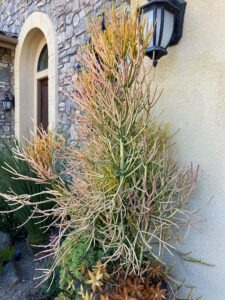Eye Hazard: “Sticks on Fire” Plant Sap
- June 13, 2021
While San Diego drought conditions continue, more homeowners are replacing water-thirsty lawns with drought-tolerant plants. One of the common plants used in xeriscape is the striking “sticks on fire” plant, or Euphorbia tirucalli. But did you know that this plant can also cause horrible eye pain?
A Plant with Many Names, Common in San Diego
Also referred to as a pencil tree, pencil cactus, fire sticks, and milk bush, this plant adds fiery color with vertical elements to contrast with other succulent plantings. Most San Diegans will recognize these plants in their neighborhood. One of the larger displays of “sticks on fire” is adjacent to the Torrey Pines High School tennis courts, visible after driving into the entrance off Torrey Highlands Park from Lansdale Drive.
The beauty of Euphorbia tirucalli hides the fact that its milky white sap packs a debilitatingly painful punch if it gets on your eye. The “sticks on fire” plant is in the Euphorbia genus of plants with over 2,000 species. Perhaps the best-known Euphorbia is the poinsettia. A common feature of Euphorbias is that they produce a white milky sap, or latex, which irritates human skin and mucous membranes.
Proper Treatment Often Elusive
Although the ocular toxicity of Euphorbia sap is documented, relatively few eye care professionals, have experience managing these cases. If you have the misfortune of getting Euphorbia sap in your eye, do not delay and immediately seek care with an eye care professional. Make sure you let your practitioner knows that the sap you got in your eye is known to cause toxicity to the eye.
Patients with Euphorbia sap in their eye commonly have incapacitating eye pain which can worsen initially before improving. The symptoms can last for several days even with proper treatment. Healing of the eye is often slow due to a chemical found in the Euphorbia sap called diterpenoid diester.
Precautions with “Sticks on Fire”
The “sticks on fire” plant can grow up to 4 to 8 feet tall, which means that periodic pruning is expected. When pruning or handling this Euphorbia tirucalli, wear gloves and eye protection! A responsible homeowner should also warn neighbors not the handle this plant, particularly so that children do not play with it. The excruciating disability caused by the milky sap of the “sticks on fire” plant when it gets into the eye is usually a painful lesson that teaches one quickly that it should never be repeated.
Related Eye Danger with “Milkweed”
The genus Asclepias of flowering herbaceous perennials known as milkweeds, due to their milky latex exuded when damaged, are also known to cause toxicity to the human eye. The latex of milkweeds includes cardiac glycosides or molecules that stimulate contractions of the heart and its output. When transferred to the eye, commonly from inadvertent eye rubbing, the latex of milkweeds can cause swelling of the cornea. Treatment usually requires topical corticosteroid eye drops.
If you get plant sap in your eye, immediately flush your eye out copiously with eyewash or saline and seek care by your eyecare professional. If you are in San Diego, ReVision Optometry may be able to help during our normal operating hours. Call our office at 619-299-6064.
